Looking to level up your adobo game? This recipe is your new secret weapon. By adding a simple tin of liver spread to the classic Filipino favorite, you'll get an adobo that's richer and more velvety than you've ever tasted.
It's still that same comforting dish you love: tender chicken swimming in a tangy-savory sauce - but with a flavor upgrade that'll make everyone think you spent hours in the kitchen (when really, it's just as easy as regular adobo).
Jump to:
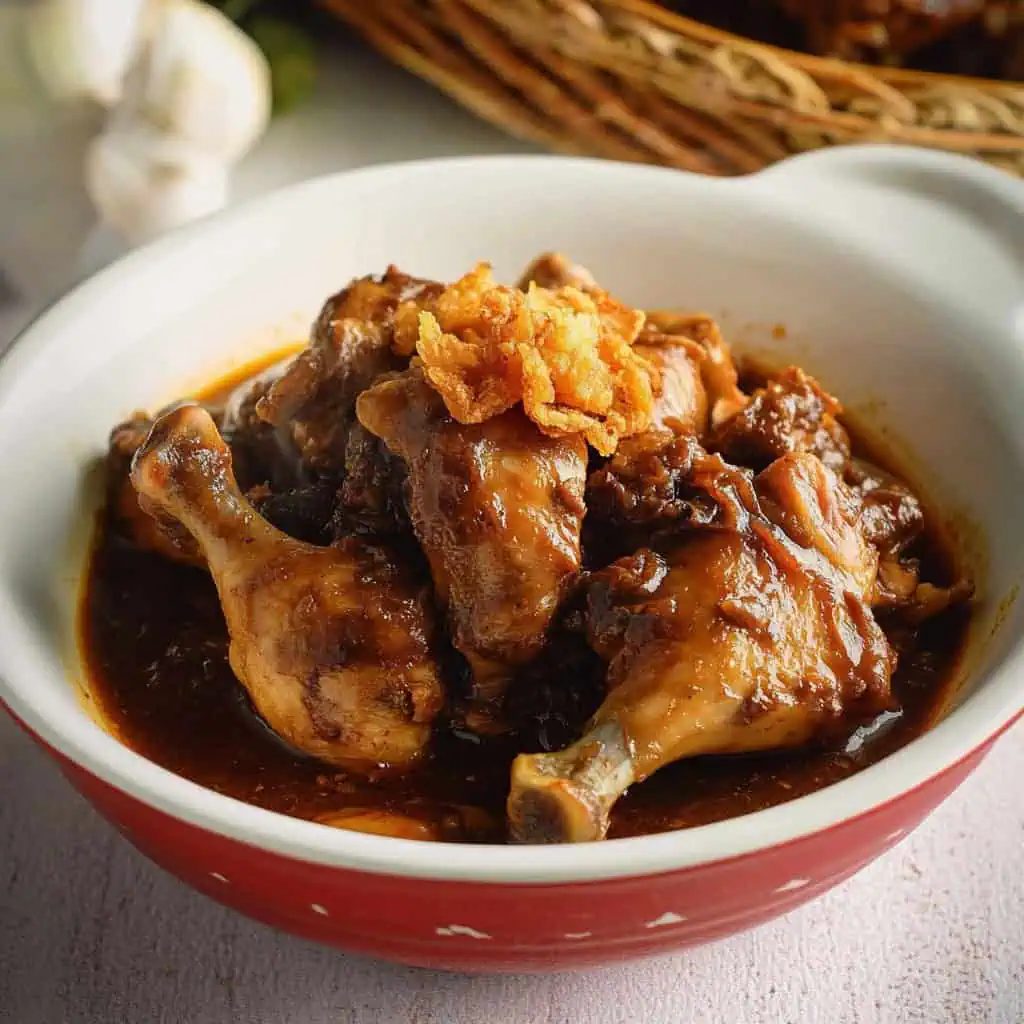
Why You'll Love This Recipe
- Extra rich and velvety sauce from the liver spread (atay)
- One-pot cooking means minimal cleanup
- Ready in under an hour
- Budget-friendly comfort food
- Perfect make-ahead dish (tastes even better the next day!)
- Restaurant-quality results with home kitchen ingredients
Ingredients
This recipe combines classic adobo ingredients with liver spread for good reason. The vinegar tenderizes the chicken while balancing the salty soy sauce. Bay leaves add subtle warmth and depth, while a whole head of garlic provides that unmistakable adobo backbone.
The star addition — liver spread — transforms the simple braising liquid into a velvety, rich sauce that clings perfectly to the meat. This ingredient doesn't overpower but instead adds a subtle complexity that makes people wonder what your secret is.
Together, these simple ingredients create layers of flavor that develop beautifully as they simmer, resulting in a dish that tastes like it took much more effort than it actually did.
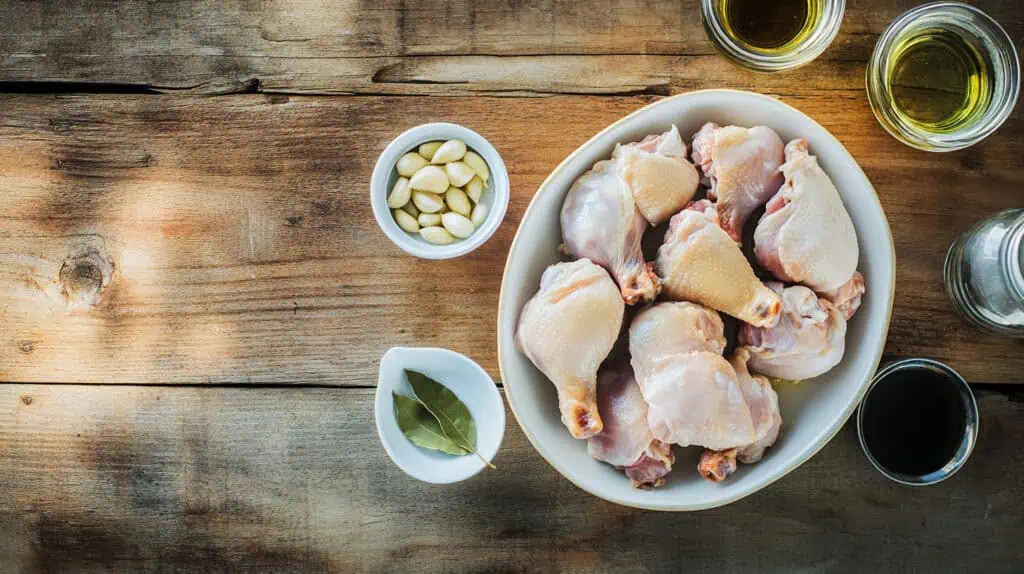
- 3 pounds chicken, cut into serving pieces
- 1 whole head garlic, peeled and minced
- 1 cup white vinegar
- ½ cup soy sauce
- 1 cup water
- 2 bay leaves
- 1 tablespoon cooking oil
- ¼ cup liver spread
- Salt and pepper to taste
Equipment
- Large heavy-bottom pot or Dutch oven: Ensures even heat distribution for perfectly cooked chicken and sauce
- Sharp knife: For cutting chicken into serving pieces cleanly
- Wooden spoon: Prevents scratching your cookware while stirring the sauce
- Measuring cups and spoons: For precise ingredient measurements
- Garlic press: Makes mincing a whole head of garlic quick and easy
- Meat thermometer: Helps ensure chicken is properly cooked to 165°F
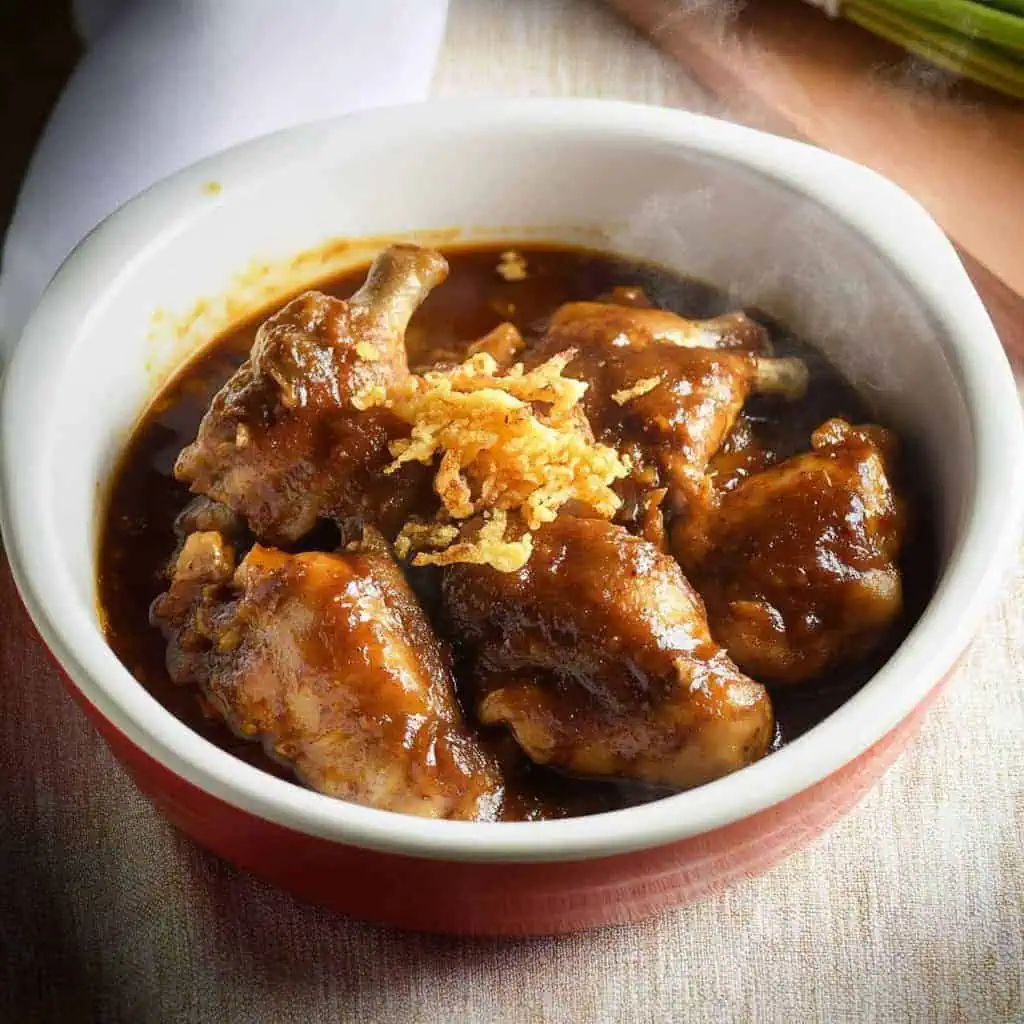
How To Make
- Heat oil in a large pot over medium heat. Once hot, add minced garlic and cook until golden and fragrant, about 2-3 minutes.
- Add chicken pieces to the pot. Cook until they turn light brown on the outside, turning occasionally, about 8-10 minutes.
- Pour in the vinegar and let it come to a boil. Important: don't stir for the next 3-5 minutes. This helps remove the harsh vinegar taste.
- Add soy sauce, water, and bay leaves to the pot. Let everything boil together for 2-3 minutes. Reduce the heat to low, cover the pot, and let it simmer gently for 20-30 minutes until your chicken is cooked through and tender.
- Season with salt and pepper as needed. Now comes the special part - add your liver spread and stir it into the sauce until it's completely mixed in. Cook for another 2-3 minutes until your sauce becomes thick and velvety.
- Check doneness by ensuring meat near the bone is no longer pink. The sauce should nicely coat the back of your spoon. Remove bay leaves and let everything rest for 5 minutes - this helps the sauce thicken up even more and lets the flavors settle.
- Serve hot over freshly cooked rice. Spoon extra sauce over the chicken and rice - it's the best part!

Tips from Lola's Kitchen
- Use native chicken for more flavorful results
- Don't rush the vinegar boiling step - it's crucial for developing the proper flavor
- Let chicken marinate in garlic for 30 minutes before cooking if time permits
- Always use room temperature chicken for even cooking
- For deeper flavor, brown the chicken pieces thoroughly before adding liquids
- The sauce will continue to thicken as it cools, so don't reduce it too much
- This dish tastes even better after sitting overnight in the refrigerator
Substitutions
- Liver spread: Use 1 cup of fresh chicken liver, boiled and mashed
- White vinegar: Apple cider vinegar or cane vinegar work well
- Soy sauce: Liquid aminos or coconut aminos for a gluten-free option
- Chicken parts: Can use all thighs, drumsticks, or wings depending on preference
- Bay leaves: 1 teaspoon dried oregano can substitute in a pinch
- Garlic: 2 tablespoons garlic powder if fresh isn't available (though fresh is strongly recommended)
Troubleshooting
- Sauce too thin? Simmer uncovered for 5-10 more minutes
- Too salty? Add a quartered potato to absorb excess salt, or stir in a small amount of water
- Too sour? Add a pinch of sugar to balance the acidity
- Sauce curdling? Lower heat and stir continuously when adding liver spread
- Chicken not tender enough? Extend simmering time by 10-15 minutes, adding water if needed
- Garlic burning? Lower heat immediately and add a splash of water
Storage & Reheating
- Refrigerator: Keeps for 3-4 days in an airtight container
- Freezer: Lasts up to 2 months in freezer-safe containers
- Reheating on Stovetop: Medium-low heat until internal temperature reaches 165°F, adding a splash of water if sauce is too thick
- Microwave Reheating: Heat in 1-minute intervals, stirring between each until thoroughly heated
- For Best Results: Allow refrigerated adobo to come to room temperature before reheating
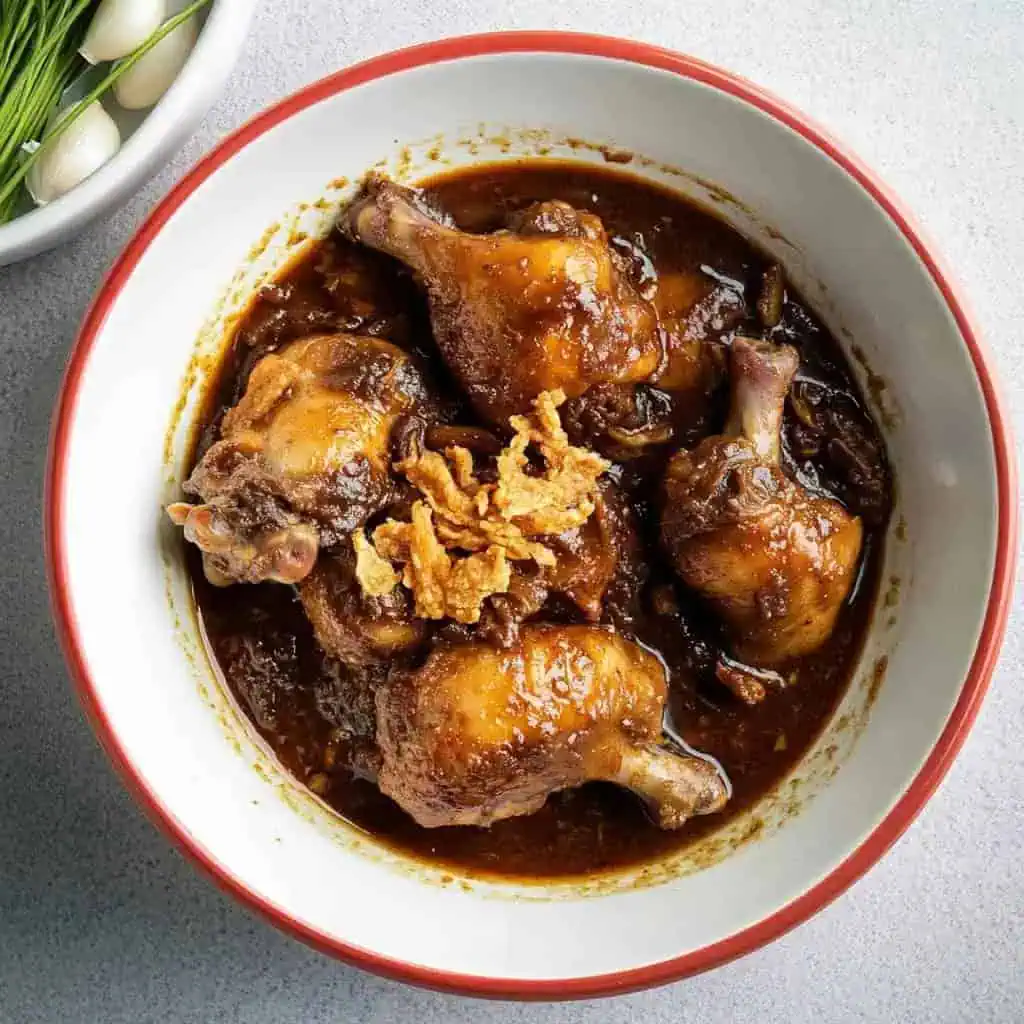
FAQ
Can I make this ahead?
Yes, it actually tastes better the next day as flavors deepen overnight!
Why can't I stir the vinegar right away?
This allows the harsh vinegar taste to evaporate properly for a more balanced flavor.
Can I use chicken breast only?
Yes, but cooking time will be shorter (15-20 minutes) and the meat won't be as tender as thighs.
Is this keto-friendly?
Yes, just omit any added sugar and serve without rice.
How do I know when the chicken is done?
The internal temperature should reach 165°F, and the meat should pull easily from the bone.
Can I double the recipe?
Absolutely! Just ensure your pot is large enough and adjust cooking time slightly.
What's the best liver spread brand to use?
Reno or Argentina brands work well, but any canned liver spread will do.
Can I make this in a slow cooker?
Yes, brown the chicken first, then cook on low for 6-8 hours or high for 3-4 hours.
Related
Looking for other recipes like this? Try these:

Chicken Adobo with Liver Spread
Equipment
- Large heavy-bottom pot or Dutch oven (kaldero) For even heat distribution
- Sharp knife (matulis na kutsilyo) For cutting chicken
- Wooden spoon (sandok na kahoy) For stirring without scratching the pot
- Measuring cups and spoons (Panukat) For precise ingredients measurement
- Garlic press (optional) For mincing garlic
- Meat thermometer (optional) To ensure proper cooking temperature
Ingredients
- 3 pounds chicken Manok, cut into serving pieces
- 1 whole head garlic Bawang, peeled and minced
- 1 cup white vinegar Suka
- ½ cup soy sauce Toyo
- 1 cup water Tubig
- 2 bay leaves Dahon ng laurel
- 1 tablespoon cooking oil
- ¼ cup liver spread Atay spread
- Salt Asin and pepper (Paminta) to taste
Instructions
- Start by heating your oil in a large pot over medium heat. Once hot, add minced garlic and cook until golden and fragrant, about 2-3 minutes.
- Add your chicken pieces to the pot. Cook them until they turn light brown on the outside, turning occasionally, about 8-10 minutes.
- Pour in the vinegar and let it come to a boil. Here's an important tip: don't stir for the next 3-5 minutes. This helps remove the harsh vinegar taste.
- Add soy sauce, water, and bay leaves to the pot. Let everything boil together for 2-3 minutes. Reduce the heat to low, cover the pot, and let it simmer gently for 20-30 minutes until your chicken is cooked through and tender.
- Taste and add salt and pepper as needed. Now comes the special part - add your liver spread and stir it into the sauce until it's completely mixed in. Cook for another 2-3 minutes until your sauce becomes thick and velvety.
- Before serving, make sure your chicken is fully cooked by checking that the meat near the bone is no longer pink. The sauce should nicely coat the back of your spoon. Take out the bay leaves and let everything rest for 5 minutes - this helps the sauce thicken up even more and lets the flavors settle.
- Serve your adobo hot over freshly cooked rice. Spoon extra sauce over the chicken and rice - it's the best part!
Tips from Lola's Kitchen
- Use native chicken for more flavorful results
- Don't skip the vinegar boiling step - it's crucial for taste
- Let chicken marinate in garlic for 30 minutes before cooking if time permits
- Always use room temperature chicken for even cooking
- Save bones to make stock for other dishes
Nutrition
The Story Behind Chicken Adobo with Liver Spread
In the heart of Filipino home cooking lies a tale of culinary innovation - the marriage of classic chicken adobo with liver spread, a combination that transforms an already beloved dish into something extraordinarily rich and complex. While traditional adobo, with its perfect balance of vinegar and soy sauce, has been gracing Filipino tables for centuries, this modern adaptation speaks to the Filipino cook's ingenious spirit of making something great even better.
The origins of this variation can be traced to the post-World War II era when canned goods, including liver spread, became readily available in Philippine markets. Home cooks, always experimenting with ways to enhance their adobo, discovered that adding liver spread created a luxuriously thick sauce that clung beautifully to the meat - a quality highly prized in Filipino cuisine. This simple addition turned the everyday adobo into a special occasion dish, though it remained just as easy to prepare.
What makes this version particularly special is how it builds upon adobo's fundamental cooking technique of braising meat in vinegar - a method that predates Spanish colonization. The addition of liver spread doesn't just thicken the sauce; it introduces a depth of flavor that complements the dish's signature tanginess while adding a subtle richness that makes each spoonful more satisfying than the last.
Today, Adobong Manok with Liver Spread has become a treasured recipe in many Filipino households, particularly popular during family gatherings and fiestas. It represents the perfect blend of traditional cooking methods with modern ingredients, showcasing how Filipino cuisine continues to evolve while maintaining its core identity. Whether served at a humble family dinner or a grand celebration, this dish exemplifies the Filipino talent for transforming simple ingredients into something extraordinary.
The beauty of this version lies not just in its taste but in its accessibility. It requires no special skills or hard-to-find ingredients, yet delivers a complexity of flavor that might suggest otherwise. It's a testament to the Filipino cooking philosophy that sometimes, the simplest additions can create the most memorable meals.
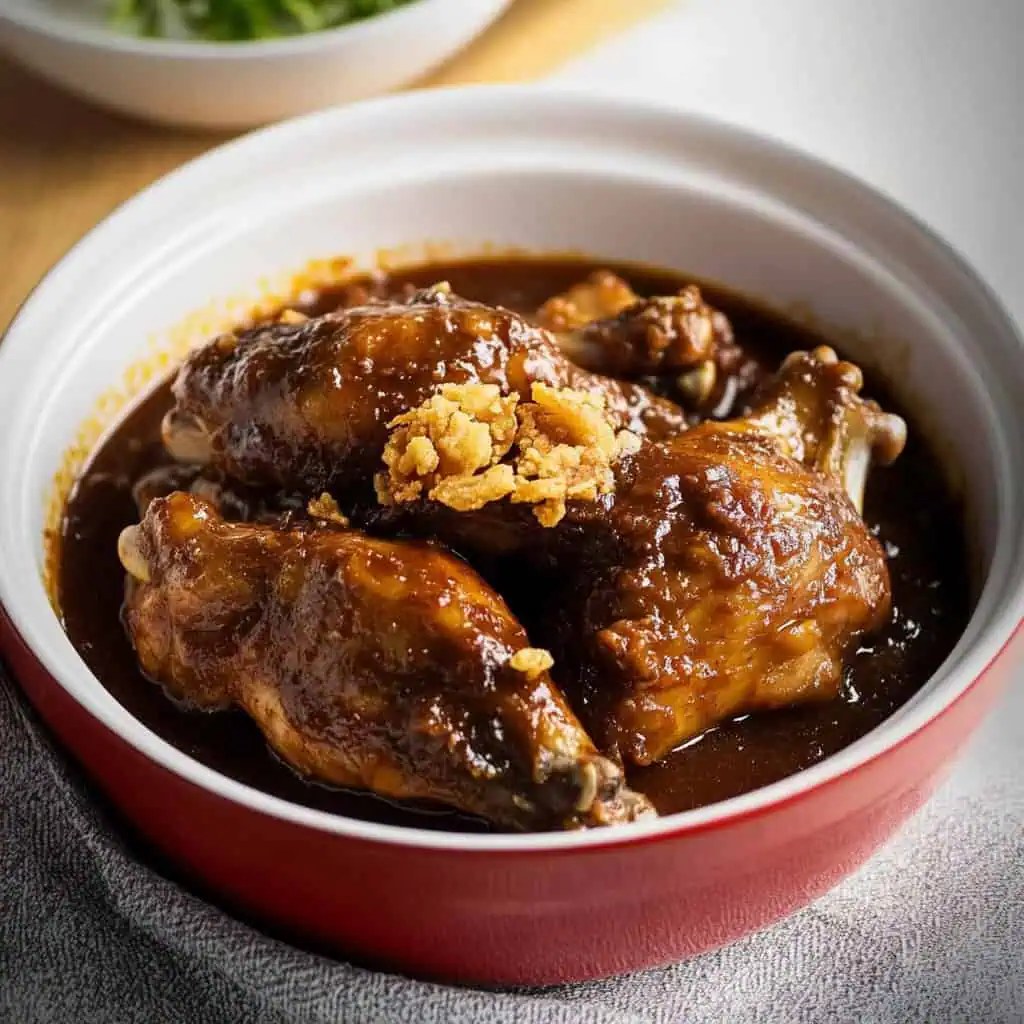









Comments
No Comments